
views
- Cut the top off of a plastic bottle and add 1 cup (237 ml) of vinegar, ½ cup (100 g) of sugar, and 1 cup (237 ml) of water. Set the inverted top into the bottom to create a wasp trap.
- Or, make a homemade insecticide by filling a spray bottle ¾ full of water and ¼ full of dish soap. Spray any wasps you see to kill them.
- As an alternative, open the window or door nearest to the wasp. Give them time to fly back outside, or blow them out with a fan or hairdryer.
Wasp Trap

Cut through an empty 2-liter plastic bottle ⅓ of the way down. If there’s a lone wasp buzzing around your house, use this simple trap to capture them without getting your hands dirty. Use a pair of sharp scissors to carefully cut the top ⅓ off of a plastic bottle. If your scissors aren’t sharp enough to pierce through the bottle, use an exacto knife, box cutter, or razor blade.

Add apple cider vinegar, sugar, and water to the bottom of the bottle. Wasps are attracted to vinegar and sugar, which makes this bait a super effective trap. Just pour in 1 cup (237 ml) of apple cider vinegar, ½ cup (100 g) of granulated sugar, and 1 cup (237 ml) of water into the bottle. Then, mix the ingredients together to dissolve the sugar. As an alternative, pour 1 cup (237 ml) of juice, beer, or sugar water into the bottle and add a few squeezes of dish soap. The dish soap reduces the surface tension of the water, which helps drown the wasp. Make your bait more attractive by placing bits of apple, banana, or hotdog into the bottle. Feel free to use this trap outside, too. Just use the vinegar-based bait, as vinegar isn’t very attractive to honey bees.
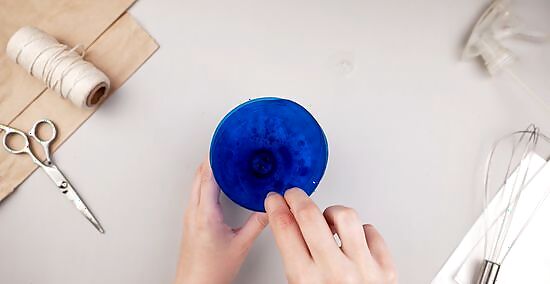
Invert the top ⅓ of the bottle and slide it into the base. Just turn the top of the bottle upside down and place it inside the bottom of the bottle. Now, when the wasp smells the bait, they’ll have to travel through the narrow opening to get it. They’ll fly right into the liquid and won’t be able to get out.

Tape the bottle pieces together and place it where you see the wasp. Secure the 2 pieces of the bottle together with tape so the wasp has no chance of flying out. Then, set it in the room where you see the wasp. Or, get it out of a room you want to use by placing it in a nearby area. If you want to hang the trap, poke a hole on each side of the bottle with a knife. Then, thread a piece of string or twine through the holes and tie them to a bookshelf, cabinet, or wall in your house.
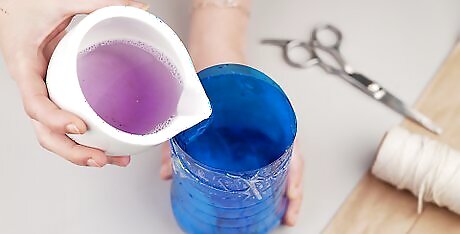
Check the trap regularly, then empty it once you catch the wasp. It might take several minutes or hours for the wasp to get stuck inside your trap. If you’re dealing with more than 1 wasp, empty the trap after you’ve caught a few. Then, refill the container with fresh bait. If too many wasps die in the container, they might prevent new wasps from drowning. Make sure the wasp or wasps are completely dead before emptying the trap. Simply throw away the trap in your trash can, or pour out the bait outside. Do not crush or squish the wasp, as wasps release a scent that can attract nearby wasps to your home.
DIY Wasp Spray

Fill a spray bottle with 3 parts water and 1 part dish soap. Making a natural spray is a great alternative to commercial insecticides, which can be harmful to pets and people. Just pour water into a spray bottle until it’s ¾ full. Then, fill the rest of the bottle with dish soap. Give the bottle a good shake to fully mix the ingredients. This is a pretty simple but effective insecticide. Most insects, like wasps, breathe through their skin. The soap covers the wasp’s skin, which causes them to suffocate. Alternatively, use tea tree castile soap or peppermint castile soap in place of dish soap. The soaps suffocate the wasps in a similar way, while the peppermint or tea tree oils help repel any other wasps nearby.

Spray the solution on any wasps you see in your home. When you spot a wasp, stand close enough to aim and spritz it with the spray, but give yourself enough distance to coat it before it flies off. Just hit it with about 5 to 10 sprays, or until it’s thoroughly soaked with the insecticide. The soap solution typically works quickly. Just wait until the wasp has completely drowned and suffocated before carefully wrapping it in a paper towel and throwing it away in your trashcan.

Be careful of using this method if you’re allergic to wasps. When you use an insecticide spray, you have to get close to the wasp or wasps to spray them. Wasps often get defensive when they’re threatened, so they might try to sting you. If you’re allergic to wasps, either get someone else to spray the wasps, use another method, or call an exterminator.
Forcing Wasps Out
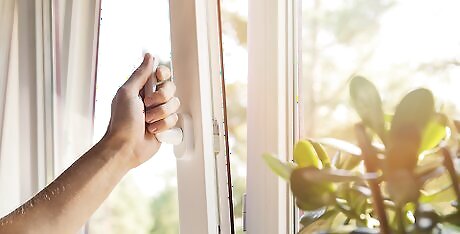
Open the window or door nearest to the wasp, then close off the room. Sometimes, the best way to get rid of a wasp is to give it an easy way out. Find the wasp in your house and crack open the window or door that’s closest to it. Then, close the doors to the room so the wasp can’t fly into a different area of your home. Just check on the wasp regularly to make sure it leaves, then close the open window or door.

Blow the wasp out of your house with a fan. Take a more direct approach and force the wasp out of your house yourself. Just plug in a portable fan, hair dryer, or another tool that blows air quickly and forcibly. Open the door or window nearest to the wasp and aim your fan at it. Keep blowing the air at the wasp until it is pushed back outside.

Make a fake nest and hang it near the wasp’s nest to scare them away. Wasps are territorial creatures, so they often leave if they think another colony has moved into their neighborhood. Just pack a plastic bag tightly with shredded paper. Then, crumple a paper bag and place the plastic bag inside. Punch a hole through the top and string a piece of twine through it. Then, hang your fake nest outside near the wasp’s nest so they notice it. It might take a few hours or days for the wasp colony to notice the fake nest and vacate the area. Using a plastic bag for your nest helps it better withstand any rain, wind, and other elements outside.
Removing a Wasp Nest

Identify the type of wasp you’re dealing with. If you’re noticing a lot of wasps indoors, your best bet to fully get rid of them is to take out their nest. Most wasps form distinctive nests that help you determine what kind is buzzing around your house. Some types also get more aggressive than others, such as hornets, so it’s typically best to leave the removal of those up to the professionals. Yellowjackets are black with bright yellow stripes. While they look similar to bees, they have a distinctive, pinched-in waist. They typically make their nests underground and are aggressive. Paper wasps are usually brown or reddish brown. They build paper-like, umbrella-shaped nests under eaves, gutters, and ledges. They are usually pretty docile. Hornets, such as baldfaced hornets, are jet black with a white face. They make gray, football-shaped nests in trees, bushes, and on the sides of buildings. They are very aggressive when disturbed, so call a professional to take care of them. Mud-daubers are long and thin with black and yellow or black-blue bodies. They form their nests out of mud, which usually looks like long, thin tubes, under eaves and porches. They’re typically docile, as they do not live in colonies.
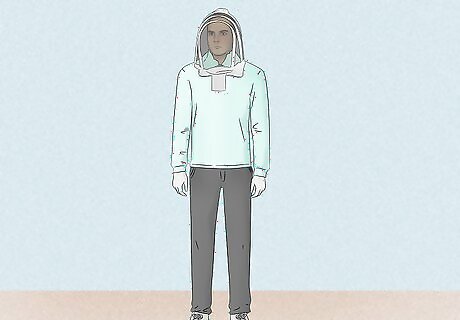
Put on long pants, long sleeves, gloves, and a veil over your face. Even when you’re dealing with a more docile wasp like the paper wasp or mud-dauber, protect yourself against potential stings. Wear long sleeves, pants, gloves, and tie a bandana or scarf around your face. If you happen to have a bee-keeping suit, just put that on. If you’re allergic to wasps, don’t remove the nest yourself. Instead, call an exterminator who will safely take it down for you.

Spray the nest with an aerosol wasp spray at night. The best time to attack the nest is at night when most wasp species are the least active. Most sprays have a range of 15 to 20 feet (4.5-6 m), so stand as far away as possible. Aim for the main opening, which is usually at the bottom of the nest, and spray for at least 10 seconds. Spray any other holes you see, rotating between them and the main opening. When you see wasps emerging, leave the area quickly. Only spray nests that you can easily get to and escape from. If you need a ladder to reach the nest or it’s hard to get in and out of the area, let a professional handle it. Because paper wasps and mud daubers aren’t very aggressive, simply knock the nest down instead. Stay at a safe distance and use a broom, mop, or another tool with a handle to scrape off the nest. If you’re dealing with a small paper wasp nest, use the dish soap spray to kill them.
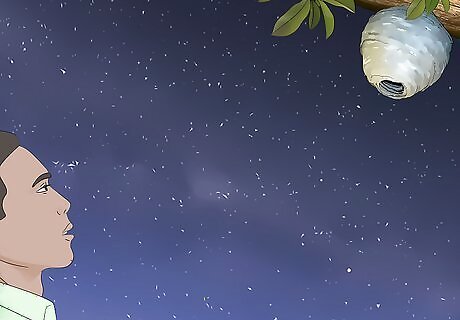
Monitor the nest for wasp activity and spray it again, if needed. The next day, look for wasps flying in and out of the nest or buzzing around it. Just follow the same steps as above to spray the nest and knock out the remaining wasps.

Knock down the nest once it’s dry. Wait for the insecticide to fully penetrate the nest and dry out before taking it down. Then, use the long handle of a broom or mop to knock the nest down. Gather it up in a trash bag then throw it away in a sealed trash can. Or, to prevent a potential mess, wrap the trash bag around the nest before knocking it down. Break it off while it’s in the bag, seal it, then throw it away.
Wasp Prevention

Repel wasps with lemongrass, clove, and geranium essential oils. Wasps can’t stand certain smells, so use their least favorite scents to keep them away. Just mix several drops of lemongrass, clove, and geranium essential oils into a spray bottle. Fill the rest of it with water and several squeezes of dish soap. Then, spray the solution wherever you typically see wasps. Rosemary and thyme also work well as natural repellents.

Put food away and clean up spills when they happen. Like many pests, wasps are attracted to food—especially foods that are high in sugar and protein. Wipe up crumbs and spills when you see them and don’t leave food outside for long. If you keep pet food or bird feed outside, store it in a sealed container. Then, make sure that your trash cans and recycling bins are tightly sealed too. Place bird feeders far from your house to prevent wasps from finding their way inside. If you have fruit trees, pick up any dropped fruit from the ground. When you’re eating outside, keep your food and glasses covered to keep roaming wasps away. If they get close, just stay still or slowly and gently shoo them away.

Seal holes and cracks around your house with caulk. Walk around your home and look for unsealed vents, torn screens, cracks around windows and door frames, or open dampers. Fix torn screens by sewing the tear together or replacing the entire screen. Then, apply caulk or expanding foam to close off any openings so the wasps no longer have entryways into your home. If you don’t have screens on your doors or windows, add them. This way you can still enjoy a nice breeze without worrying about wasps coming inside. If a wasp nest is located inside a hole in your foundation or siding, do not close it off. Closing off the wasps’ entryway can cause them to tunnel inside your house. These nests are tricky to get rid of by yourself, so call an exterminator to remove them.

Avoid swatting or crushing the wasps. Wasps typically mind their business when they’re undisturbed. If you threaten them by swatting at them or making other sudden movements, they get defensive and might sting. Squishing wasps is also counterproductive, as they release a pheromone that attracts nearby wasps to the threat, aka you. Instead, simply stay still or walk away from any hovering wasps.




















Comments
0 comment